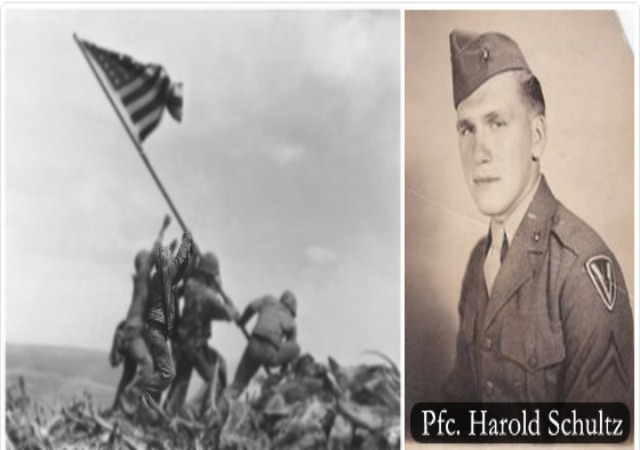Marine Misidentified in Iwo Jima Photo

The Marine Corps discovered officials misidentified Harold Shultz, a private first class from Detroit, MI, in the famous Iwo Jima picture.
The investigation also found that John Bradley, a Navy hospital corpsman, did not raise the flag. Bradley’s son “wrote a best-selling book about his father’s role in the flag-raising that was made into a movie directed by Clint Eastwood.”
Schultz always knew he was in the picture, but never spoke about in public.
Schultz spoke about it once at a family dinner in the 1990s:
“My mom was distracted and not listening and Harold said, ‘I was one of the flag raisers,’ ” his stepdaughter, Dezreen MacDowell, said in a telephone interview on Wednesday.“I said, ‘My gosh, Harold, you’re a hero.’ He said, ‘No, I was a Marine.’ ”“After he said that, it was clear he didn’t want to talk about it,” she said. “He was a very self-effacing Midwestern person. He was already sick, and died two or three years later.”
Schultz passed away in 1995 after working as a mail sorter.
The Marine Corps opened the investigation after producers of the documentary “The Unknown Flag Raiser of Iwo Jima” asked questions. Retired Marine Matthew Morgan, one of the producers, told the Marines about evidence that the men in the photograph were misidentified.
The producers saw that Bradley wore different clothes from those in the photo. Charles Neimeyetr, chief historian of the Marines, has heard people say they are in the photo, but with no proof. Neimeyer decided to take the producers seriously after they showed him the pictures.
Marine Corps’ commandant Gen. Robert Neller demanded a review panel led by retired general officer Jan Huly, “active duty and retired Marines, as well as two military historians.” From CNN:
“Our history is important to us, and we have a responsibility to ensure it’s right,” Neller said in a statement from the Marine Corps.—“Although the Rosenthal image is iconic and significant, to Marines it’s not about the individuals and never has been,” Neller said in a statement. “Simply stated, our fighting spirit is captured in that frame, and it remains a symbol of the tremendous accomplishments of our Corps — what they did together and what they represent remains most important. That doesn’t change.”
Associated Press photographer Joseph Rosenthal captured the image on February 23, 1945. 6,800 Americans died in the battle, but they took the “strategically important island in the Pacific.” Newspapers across the country published the picture on the front page, “quickly becoming a symbol of the sacrifices American service members at war were willing to make.”
And Schultz’s humble nature reminds us once again why the world considers them the Greatest Generation.
(H/T Sean Agnew)
[Featured Image via Twitter]
CLICK HERE FOR FULL VERSION OF THIS STORY